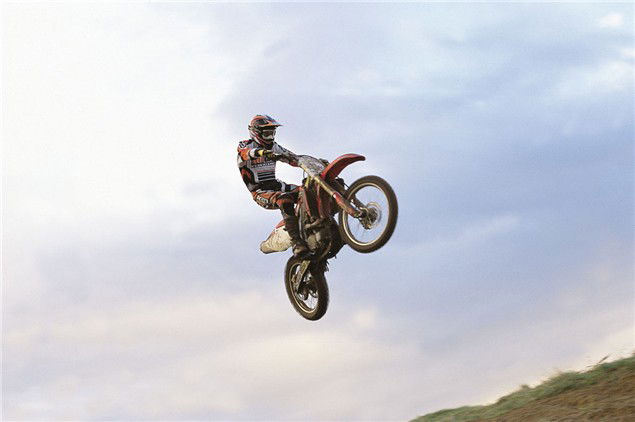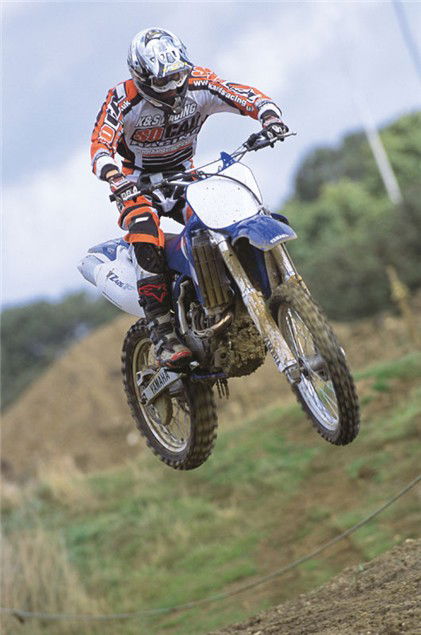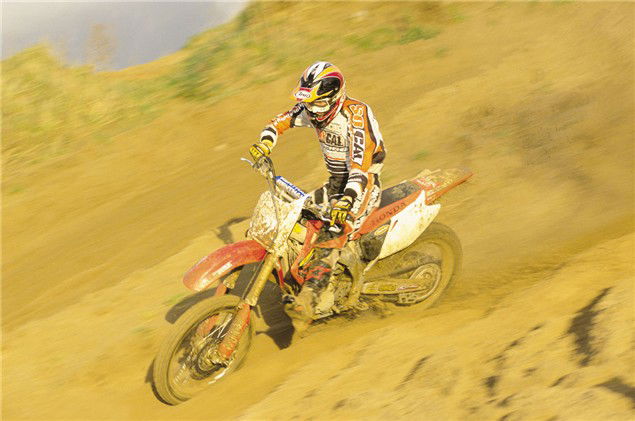Road Test: Honda CRF450 vs. Yamaha YZ426
With two new shattering four-stroke dirtbikes available for 2002 in the shape of the Honda CRF450 and Yamaha YZ426, we sent our resident off-road specialist Steven Pheasant to various mudholes around the UK to figure out who's packing the big gun.

 |
Just as four-strokes are set to turn the world of motorcycle Grand Prix racing on its head, so the four-valves are doing the same in motocross. Forget the 'thumpers' of old - this new generation of four-stroke motocrossers aren't just keeping up with the traditional yowling two-strokes - they're ready to wipe the bleedin' floor with them. Both Yamaha and Honda have their new toys locked and loaded for the 2002 season, so please enter stage left Yamaha's YZ426, and Honda's all-new CRF450.
The YZ426 has been around since 1999 and before that in the guise of the YZ400. Yamaha - innovators as ever - were the first out the gate of the Japanese companies with a small, revvy four-stroke dirtbike package, and the 426 is a massive seller for Yamaha. These new four-strokes aren't only as quick as the 250 strokers, they're also much easier to live with (less gearchanges) lower maintenance (no new rings and pistons every half-dozen races) and in muddy conditions, they hook up loads better (smooth four-stroke grunt). With the currently-developing interest in supermotard on and off the road, we wouldn't be surprised if Yamaha had a road-legal 426-based supermoto in the wings.
The Honda CRF450 is the off-road equivalent of the original FireBlade. It's been talked about and rumoured for the last 18 months, and now that it's finally arrived is causing all sorts of upset. It's faster than many of the 250 two-strokes it will be racing against in 2002, and this in its inaugural year. To look at, the CRF450 is tiny, far smaller than a 250 'crosser and certainly more petite than the butch YZ426, and this makes (potentially) makes it much easier for people to get on with straight away.
"Like getting on a 125 in terms of size," said TWO tester and national 250 rider Steve Pheasant. "It's really small! Someone who didn't know anything about riding a dirtbike could just get on and ride it without a problem. It's narrow, it's light, you get on and go straight off. Perfect, really. The 426 Yamaha is a much larger machine. When you come down off a jump, you can feel the extra weight. And also in the whoops - you feel the weight of the Yam. The 426 still feels big, if it kicked to the side you knew it was there. With the Honda, you didn't."
ENGINES
"In terms of revs available, they're about the same. You can hang onto a gear in to and out of a corner for about the same time. But in terms of midrange, the Honda has it. During the test we were in deep sand, and the 450 would pull me out of sandy berms in 4th gear, no problem. With the 426, you couldn't pull off the same trick. I was using 2nd gear a lot on the Honda because I'm used to two-strokes, but I could have gone a gear or even two higher in any given corner. People have said that it has the torque of a KTM520 with the revs of the Yamaha 426, and that's a pretty accurate description of the motor."
CHASSIS
"In the deep sand of the test, the alloy-framed Honda was really good. The CRF is stable, but it turns quick as well (unlike some of the earlier beam-framed Honda crossers). In a straight line and over bumps, the Honda's the best of the two again because of that stability. That said, I had no problem on the Yamaha 426. Infact on the Yamaha test day, the 426 was the best bike of all the Yamaha off-road range I rode that day. And I didn't think that of the CRF on the day - I thought the CR250 was better. Why? Because I could handle the two-stroke 250 better - it didn't seem as quick! That 450 is seriously fast, I'm telling you."
OVERALL
"The Honda is so quick it can get you into trouble, but it also gets you out of trouble. If you get all out of shape on the 450, just open the throttle and it'll get you through it, more often than not. A shorter person would probably find the Honda more suitable for them, due to its smaller dimensions. Yamaha's 426 is a physically bigger bike - wider tank, wider seat - and it's a little heavier. You can feel that, but the fact that its midrange power is a little softer than the CRF makes it easier to ride in some conditions.
CONCLUSION
"You can put these 400s in one gear and ride round where on a 250 stroker, you'd be forever changing gears. Of the two bikes here, you'll jump on the Honda 450 and go faster straight away, regardless of your ability. It's a better bike, if only because it's newer and been developed more recently the Yamaha. The Honda is also easier to start, which is important with these big four-strokes. They'll always be a bit of a knack to get going, but once you have that, you're away.
Four-strokes is where motocross is heading. It's mostly down to emissions, because California has totally banned two-strokes. California is the biggest market in the States for motocross, and what happens in the States always happens here. If you go to a club meet these days it's all four-strokes, because they're easier to get on with and you don't have to do anything to them. A four-stroke can probably do about three years racing without having to do anything on it."
Yamaha - Good and Bad Points
Bit wide, bulky, loads of power, loads of revs, easy to ride
Honda - Good and Bad Points
Slim, too quick!
...The Honda feels more powerful right across the rev-range, no question...

Link: Honda CR450X (2005) review
Link: Offroad motorcycles
Just as four-strokes are set to turn the world of motorcycle Grand Prix racing on its head, so the four-valves are doing the same in motocross. Forget the 'thumpers' of old - this new generation of four-stroke motocrossers aren't just keeping up with the traditional yowling two-strokes - they're ready to wipe the bleedin' floor with them. Both Yamaha and Honda have their new toys locked and loaded for the 2002 season, so please enter stage left Yamaha's YZ426, and Honda's all-new CRF450.
The YZ426 has been around since 1999 and before that in the guise of the YZ400. Yamaha - innovators as ever - were the first out the gate of the Japanese companies with a small, revvy four-stroke dirtbike package, and the 426 is a massive seller for Yamaha. These new four-strokes aren't only as quick as the 250 strokers, they're also much easier to live with (less gearchanges) lower maintenance (no new rings and pistons every half-dozen races) and in muddy conditions, they hook up loads better (smooth four-stroke grunt). With the currently-developing interest in supermotard on and off the road, we wouldn't be surprised if Yamaha had a road-legal 426-based supermoto in the wings.
The Honda CRF450 is the off-road equivalent of the original FireBlade. It's been talked about and rumoured for the last 18 months, and now that it's finally arrived is causing all sorts of upset. It's faster than many of the 250 two-strokes it will be racing against in 2002, and this in its inaugural year. To look at, the CRF450 is tiny, far smaller than a 250 'crosser and certainly more petite than the butch YZ426, and this makes (potentially) makes it much easier for people to get on with straight away.
"Like getting on a 125 in terms of size," said TWO tester and national 250 rider Steve Pheasant. "It's really small! Someone who didn't know anything about riding a dirtbike could just get on and ride it without a problem. It's narrow, it's light, you get on and go straight off. Perfect, really. The 426 Yamaha is a much larger machine. When you come down off a jump, you can feel the extra weight. And also in the whoops - you feel the weight of the Yam. The 426 still feels big, if it kicked to the side you knew it was there. With the Honda, you didn't."
ENGINES
"In terms of revs available, they're about the same. You can hang onto a gear in to and out of a corner for about the same time. But in terms of midrange, the Honda has it. During the test we were in deep sand, and the 450 would pull me out of sandy berms in 4th gear, no problem. With the 426, you couldn't pull off the same trick. I was using 2nd gear a lot on the Honda because I'm used to two-strokes, but I could have gone a gear or even two higher in any given corner. People have said that it has the torque of a KTM520 with the revs of the Yamaha 426, and that's a pretty accurate description of the motor."
CHASSIS
"In the deep sand of the test, the alloy-framed Honda was really good. The CRF is stable, but it turns quick as well (unlike some of the earlier beam-framed Honda crossers). In a straight line and over bumps, the Honda's the best of the two again because of that stability. That said, I had no problem on the Yamaha 426. Infact on the Yamaha test day, the 426 was the best bike of all the Yamaha off-road range I rode that day. And I didn't think that of the CRF on the day - I thought the CR250 was better. Why? Because I could handle the two-stroke 250 better - it didn't seem as quick! That 450 is seriously fast, I'm telling you."
OVERALL
"The Honda is so quick it can get you into trouble, but it also gets you out of trouble. If you get all out of shape on the 450, just open the throttle and it'll get you through it, more often than not. A shorter person would probably find the Honda more suitable for them, due to its smaller dimensions. Yamaha's 426 is a physically bigger bike - wider tank, wider seat - and it's a little heavier. You can feel that, but the fact that its midrange power is a little softer than the CRF makes it easier to ride in some conditions.
CONCLUSION
"You can put these 400s in one gear and ride round where on a 250 stroker, you'd be forever changing gears. Of the two bikes here, you'll jump on the Honda 450 and go faster straight away, regardless of your ability. It's a better bike, if only because it's newer and been developed more recently the Yamaha. The Honda is also easier to start, which is important with these big four-strokes. They'll always be a bit of a knack to get going, but once you have that, you're away.
Four-strokes is where motocross is heading. It's mostly down to emissions, because California has totally banned two-strokes. California is the biggest market in the States for motocross, and what happens in the States always happens here. If you go to a club meet these days it's all four-strokes, because they're easier to get on with and you don't have to do anything to them. A four-stroke can probably do about three years racing without having to do anything on it."
Yamaha - Good and Bad Points
Bit wide, bulky, loads of power, loads of revs, easy to ride
Honda - Good and Bad Points
Slim, too quick!
...The Honda feels more powerful right across the rev-range, no question...



